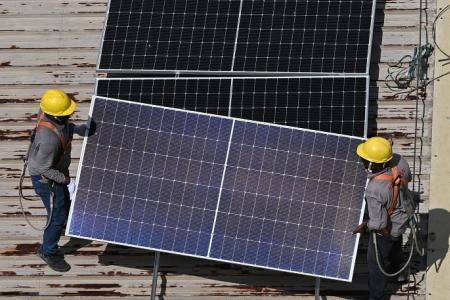No approval needed to install solar panels near airports
Businesses and building owners will no longer be required to seek approval from the Civil Aviation Authority of Singapore (CAAS) for solar panel installations in areas near Singapore’s airports from Oct 1.
This comes after a CAAS review found that improvements in solar photovoltaic technology mean that newer solar panels have reduced glare, and panels installed within critical areas close to Singapore’s airports are assessed to have minimal risk to airport operations.
This change is among several initiatives stemming from a government-wide review of rules to ease regulatory burdens for businesses. They were announced on Sept 17 by Transport Minister Chee Hong Tat at a mid-autumn festival luncheon organised by the Real Estate Developers’ Association of Singapore (Redas).
Mr Chee noted that due to concerns about glare from solar panels affecting the visibility of pilots and air traffic controllers, companies looking to install solar panels within critical areas close to Singapore’s airports have had to get CAAS’ approval.
“This process could take two months to complete, and costs around $3,500 for a consultant’s assessment report,” Mr Chee said.
CAAS has since reviewed its requirements, and will remove the need for consultant reports and applications to the agency from Oct 1. This will result in time and cost savings for businesses and building owners, he said.
Other new initiatives to help businesses include an artificial intelligence (AI) chatbot with knowledge of Land Transport Authority (LTA) regulations, and road design templates that will set out guidelines and details needed for road layout submissions.
To help save time and improve productivity in the real estate industry, LTA is developing an AI chatbot with knowledge of LTA’s regulations across various types of proposals, so that it can give tailored advice to the industry as proposals are developed, Mr Chee said.
He said that while LTA publishes regulatory requirements on its website, developers and appointed contractors have said that they need a large amount of time to trawl through these publications to verify requirements relevant to their different development proposals.
“With AI, we can better support the industry,” Mr Chee added.
The minister encouraged the industry to work with LTA, as the chatbot’s effectiveness will be enhanced “when industry partners provide examples for LTA to ‘train the chatbot’”.
Mr Chee also announced new templates to ease the process for submitting road designs.
At present, LTA receives a number of road layout submissions that do not contain the required road design details or comply with the guidelines. As a result, the agency will need to ask the applicants to resubmit the details and do its best to speed up the approvals.
“Most of these submissions today are cleared within three rounds, but... can we improve the process and settle the applications in just one or two rounds?” Mr Chee asked. For more complicated cases, there could be many more rounds because of the need to go back and forth with the industry to revise the plans.
“It is a lose-lose and unproductive process for everyone,” he added.
To tackle this, LTA is developing a set of road design templates laying out the guidelines and details to be presented for road layout submissions.
These templates, which are targeted for release by November, will provide clear regulatory guidance upfront, while leaving room for developers to be creative in the design process, said Mr Chee.
The aim is to make the process more efficient, reduce the number of revisions, and ensure consistency with regulatory requirements, thereby allowing LTA to shorten the process for more complicated cases by several months, he said.
Mr Chee noted that a Transport Infrastructure Collaboration Panel was started in 2021 to bring together regulators and industry leaders to tie up on addressing issues and drive pro-business initiatives.
One positive outcome of the panel, Mr Chee noted, was to streamline the handover of road infrastructure.
Previously, new streets constructed by private developers underwent a process spanning more than eight months after the defect liability period before they could be handed over to LTA. The industry had frequently cited this as a pain point, he said.
Since June 2022, LTA has restructured its process to eliminate steps including joint site inspections of common road facilities to save time for developers.
As a result, developers can now hand over completed roads to LTA earlier, as fast as within a month after the defect liability period, Mr Chee said.
He added that a digital platform called CoreNet X will allow project teams to make submissions for building works, so that agencies can review them jointly and issue a coordinated response.
It has been open for voluntary submission since June, and will be rolled out fully in the next few years.
“By coordinating project submissions upfront, potential design conflicts can be detected and resolved earlier. This reduces the occurrence of costly abortive works downstream,” he said.
In a speech at the luncheon, Redas president Tan Swee Yiow said developers support Singapore’s green landscape, but he noted that the financial strain can be challenging due to rising construction and labour costs, and the substantial upfront expenses needed for green development.
“We need more support in the form of tax reliefs, grants, incentives, as well as consumer buy-in. This would help offset the costs and encourage green financing,” he said.
Get The New Paper on your phone with the free TNP app. Download from the Apple App Store or Google Play Store now


